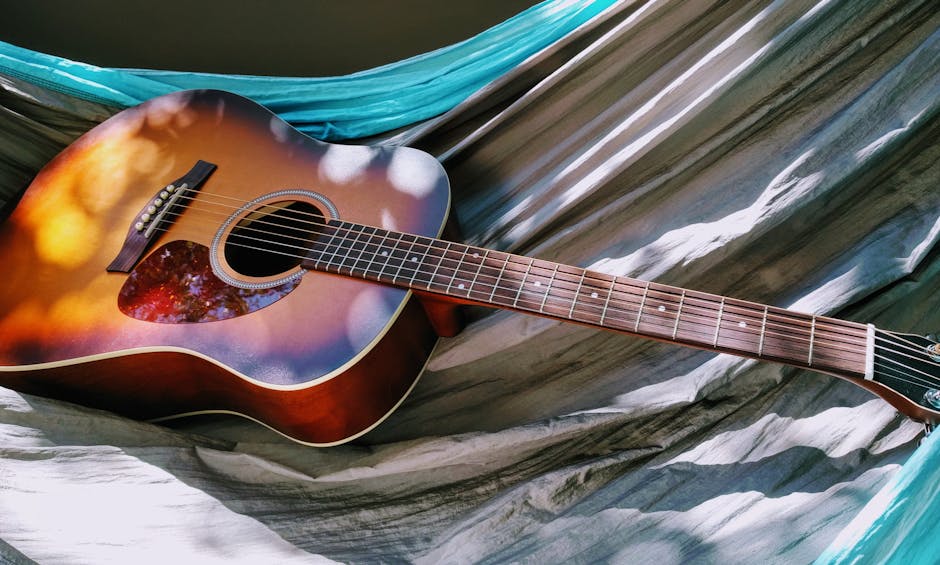Picture this: You’re strumming away on your trusty guitar, belting out your favorite tunes like a rockstar. But then, disaster strikes – a string breaks, the tuning peg gets stuck, or the frets start buzzing like a swarm of angry bees. Fear not, dear reader, for we are here to be your guitar maintenance gurus. In this article, we will guide you through the murky waters of common guitar problems and show you how to fix them like a pro. So grab your tools, tune up that old six-string, and let’s dive into the wonderful world of guitar maintenance!
Contents
- 1 Understanding the Importance of Guitar Maintenance
- 2 Identifying Common Guitar Problems
- 3 Adjusting String Action for Optimal Playability
- 4 Solving Intonation Issues for Better Tuning Stability
- 5 Repairing Fret Buzz: Causes and Solutions
- 6 Maintaining the Guitar’s Neck for Long-Term Health
- 7 The Essentials of Guitar Cleaning and Polishing Techniques
- 8 FAQs
- 9 Strumming Along
Understanding the Importance of Guitar Maintenance
So you’ve finally fulfilled your childhood dream of owning a guitar. Congratulations! But wait, before you start strumming away, have you considered the importance of guitar maintenance? Yes, that’s right – just like any valuable possession, your guitar also requires some tender loving care. Here’s why you shouldn’t neglect it:
Prevent those pesky string breakages: Guitar strings are like the fragile heartstrings of your instrument. If you neglect maintenance, they’re bound to snap on you at the most inconvenient moment. Trust me, you don’t want to be serenading your crush only to have a string snap and ruin the moment. Take care of those strings!
Keep your guitar looking sharp: A well-maintained guitar is like a well-groomed pet - it just looks better. Regular cleaning and polishing will not only preserve the beauty of your instrument but also make you look like a responsible guitar owner. Plus, who doesn’t love a shiny, gleaming guitar that’s a pleasure to look at?
Avoid those costly repairs: Neglecting your guitar’s maintenance is like ignoring a ticking time bomb. Eventually, problems will start to pile up, and before you know it, you’re faced with a hefty repair bill. Do yourself a favor and invest a little time and effort in taking care of your guitar. Your wallet will thank you later!

Identifying Common Guitar Problems
Anyone who has ever played the guitar knows that it can come with its fair share of quirks and issues. Here are some common guitar problems that are sure to make you want to put down your pick and run for the hills:
1. String buzz: You’re strumming along, basking in the glory of your own musical genius, when suddenly you hear that dreaded buzzing sound. It’s like a bee is trapped inside your guitar and trying to escape. Is it haunted? Is it cursed? Nope, just a classic case of string buzz.
2. Out-of-tune strings: You pick up your guitar, ready to serenade your love interest with a beautiful ballad, only to discover that your strings are horribly out of tune. Instead of love-struck gazes, you get a cringe-inducing cacophony of dissonance. Who needs romance when you have wonky strings, right?
3. Cracked guitar body: You’re playing a particularly riveting solo when suddenly you notice a crack starting to form on the body of your beloved guitar. Is your playing just too fierce for this world? Or did you accidentally sit on it again? Either way, you now have a guitar with a split personality.

Adjusting String Action for Optimal Playability
So you’ve got yourself a shiny new guitar, but something just doesn’t feel quite right. Maybe the strings are a little too high off the fretboard, making it feel like you’re playing a rusty old banjo from the wild west. No need to fear, my friend! With a few adjustments, you can have your guitar playing like a dream in no time.
The first step in achieving optimal playability is adjusting the string action. This is simply the distance between the strings and the fretboard. A lower string action will make playing easier and more comfortable, allowing you to shred like a rockstar without feeling like you’re climbing Mount Everest with every chord change.
To adjust the string action, you’ll need to tighten or loosen the truss rod to straighten the neck, adjust the saddle height to lower or raise the strings, and check the nut height to ensure proper string clearance. It may sound like a lot of work, but trust me, it’s worth the effort for a smoother playing experience.
Remember, the key to success is patience and a little bit of trial and error. Don’t be afraid to experiment with different settings until you find what works best for you. And if all else fails, there’s no shame in taking your guitar to a professional for some fine-tuning. Your fingers will thank you!

Solving Intonation Issues for Better Tuning Stability
So you’ve been practicing diligently, shredding those riffs like a rock star, only to find out that your guitar sounds like it’s crying out for help every time you hit a high note. Fear not, intrepid guitarist! We’re here to help you conquer those intonation issues and achieve tuning stability like never before.
First things first, let’s check your action. No, not the kind where you strut your stuff on stage – we’re talking about the height of your strings above the fretboard. If your action is too high, it’s like trying to play with a jump rope instead of a guitar string. Lower that action and watch your tuning stability soar like a majestic eagle on a windy day.
Next up, let’s talk about those pesky frets. Are they causing your strings to sound more out of tune than a tone-deaf cat? Grab yourself a fret file and get to work smoothing out those rough edges. Your fingers will thank you, and your tuning stability will be so on point, it’ll make a metronome jealous.
Finally, don’t forget about your trusty old tremolo bridge. Are those screws loose, causing your strings to waver like a flag in a hurricane? Tighten them up and watch as your tuning stability becomes as rock-solid as Mount Everest. With these tips in hand, you’ll be rocking out with perfect tuning stability in no time. Keep on shredding, you intrepid warrior of the six strings!

Repairing Fret Buzz: Causes and Solutions
Fret buzz. Those two words strike fear into the hearts of guitar players everywhere. One minute you’re jamming out to your favorite song, and the next, your beautiful music is interrupted by the dreaded buzz. But fear not, dear reader, for I am here to help you navigate the murky waters of fret buzz.
Let’s start with the causes. Fret buzz can be caused by a multitude of factors, including:
- Uneven frets
- Low string action
- Worn down frets
- Neck bowing
But fear not, for there are solutions to these pesky problems. To combat uneven frets, a little bit of fret leveling may be in order. If low string action is the culprit, try raising the action using the bridge saddles. Worn down frets? Time for a fret dressing. And if your neck is bowing, a truss rod adjustment should do the trick.
So there you have it, dear reader. The causes may be many, but with a little know-how and a touch of elbow grease, you can banish fret buzz from your life once and for all. Now get out there and play on, my friends!
Maintaining the Guitar’s Neck for Long-Term Health
Just like how you regularly change your toothbrush to keep your pearly whites shining, your guitar’s neck also needs some TLC to keep it healthy in the long run. Here are a few tips to keep your guitar’s neck in tip-top shape:
- **Keep it clean:** Dust and grime can easily build up on your guitar’s neck, so make sure to give it a wipe down with a soft cloth regularly.
- **Hydrate it:** Just like how you hydrate yourself after a long night of partying, your guitar’s neck also needs some hydration. Use a guitar-specific lemon oil to condition the wood and prevent it from drying out.
- **Adjust the truss rod:** Don’t be afraid to give your guitar’s truss rod a little tweak every now and then. Just like how you adjust your mood after a bad day, adjusting the truss rod can help maintain the neck’s straightness.
Remember, a healthy guitar neck means better playability and a longer lifespan for your beloved instrument. So, show your guitar some love and give its neck the attention it deserves!
The Essentials of Guitar Cleaning and Polishing Techniques
Let’s face it, guitars can get pretty grimy after hours of shredding. But fear not, with the right cleaning and polishing techniques, you can have your trusty axe looking shiny and new in no time!
First things first, **gather your supplies**:
- A microfiber cloth
- Guitar polish
- Guitar cleaner
- An old toothbrush (for those hard-to-reach areas)
Start by **wiping down your guitar** with a dry microfiber cloth to remove any surface dust and grime. Pro tip: make sure to pay extra attention to the fretboard and strings, as these areas tend to collect the most dirt.
Next, apply a small amount of **guitar cleaner** to a clean microfiber cloth and gently wipe down your guitar, being careful to avoid getting any cleaner on the frets or hardware.
Once your guitar is nice and clean, it’s time to **polish it up**! Apply a small amount of guitar polish to a separate microfiber cloth and buff your guitar to a beautiful shine. Your guitar will thank you!
FAQs
Why does my guitar always go out of tune?
Well, my friend, guitars are like moody teenagers – they just can’t seem to stay in tune. The most common culprit is probably your strings. Make sure they are properly stretched and, if needed, consider investing in better quality strings.
How can I get rid of that annoying buzzing sound?
Ah, the dreaded buzz. It’s like the ghost of bad playing haunting your every note. Try raising the action on your guitar, adjusting the truss rod, or even just giving your frets a good polish. If all else fails, consult a professional exorcist – I mean luthier.
What should I do if my guitar’s intonation is all out of whack?
Intonation, schmintonation. Who needs perfect pitch anyway? But if you’re a stickler for accuracy, try adjusting the saddles on your bridge until your guitar sings in sweet harmony. If that doesn’t work, well, who needs perfect pitch anyway?
How do I keep my guitar looking as shiny and new as the day I bought it?
Ah, vanity. The downfall of many a guitarist. To keep your guitar looking pristine, simply wipe it down after each use, avoid leaving it in direct sunlight, and for the love of rock ’n’ roll, put it back in its case when you’re done playing. It’s like sunscreen for your guitar.
Strumming Along
Well folks, we’ve reached the end of our guitar maintenance crash course. Hopefully, you now feel equipped to tackle those pesky buzzing strings and slippery tuning pegs like a pro. Remember, a well-maintained guitar is a happy guitar, and a happy guitar means happy jam sessions. So go forth, armed with your newfound knowledge, and strum on, my friends. Rock on!



